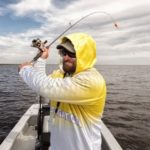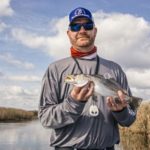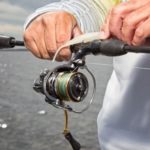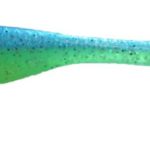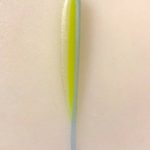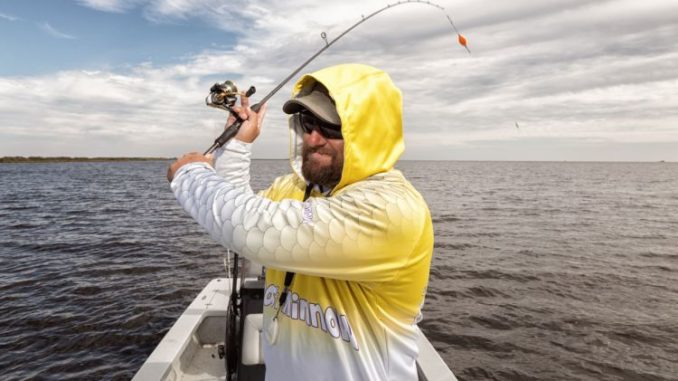
Typically, windy conditions affect an angler much more than the fish. Use these tips to keep putting specks on ice this month — even when it’s blowing.
I loathe wind.
Mainly because it always blows when I don’t want it to. But also because it seems to follow me around.
It’s not unusual for me to get texts from charter captains wondering if I was on the water without them knowing it because it was an unusually windy day – a “human wind machine,” they call me.
Although wind drains the life out of me, I learned a long time ago that wind affects me much more than it affects the fish.
Captain Lane Zimmer, who fishes out of Lafitte, totally agreed.
“I get used to fishing in the wind around here,” he said, “especially during March. Seems like the wind blows hard every day this month. For me, wind keeps me from getting to a spot, keeping me off a spot or interfering with fishing a spot.
“The trout don’t care.”
In other words, if Lane can get to his spot and make a good enough presentation with his baits, he can still catch specks.
Not too far away, Captain Travis Miller also knows all too well the problems that wind can bring to lower Terrebonne Parish.
“Wind can be very defeating,” Miller said. “I find that if we don’t get on them early when the wind is blowing hard, my anglers tend to want to give up early. I think wind definitely affect fishermen more than the fish, but you’ve got to remember that trout are a little on the dumb side.
“They’re temperamental, but not tricky to figure out… even if the wind is blowing hard.”
As Zimmer said, wind can throw some curveballs at anglers. You can still hit them out of the park — but you better make some adjustments if you don’t want to strike out.
Getting there
Don’t dare diminish the dangers of getting there during strong winds. If you know you can’t get there safely, give it up. There is no reason in the world to risk your life to catch a fish that will be there tomorrow.
The main way to get just about anywhere out of Lafitte is through Bayou Rigoletts or Bayou Perot – both of which run in a north-south orientation.
“If the wind is from the east or the west, you can get on the lee side and run,” Zimmer said. “But if it has some north in it, the run can get really bad – especially down by the Harvey Cut. That wall reflects all the wave action, and reflects it back out. That’s not where you want to be running in a small boat.”
Zimmer fishes out of a 24-foot Blazer Bay, and he knows that a bigger boat is a definite plus when running in windy weather.
Over on Bayou DuLarge, Miller, who fishes out of a 24-foot BlueWave, says that there are so many small bayous that anglers can get out of the wind to get just about anywhere.
“You’ve just got to be selective where you run,” he said. “Maybe you’re used to going one way but the wind has that all churned up. Odds are there’s another route you can take to get there.”
Where to go
When the weather forecast predicts winds in the 15 to 20 mph range, Zimmer automatically eliminates a lot of water that he knows he won’t be able to effectively fish.
“No doubt strong wind keeps you off the bigger waters,” he said. “Places like Little Lake and the Pen… I would not be in either of those because the wind just makes spots like that so hard to fish.”
It’s no different in DuLarge. While it might offer more protected places to fish than Lafitte, Bayou DuLarge has Mud Lake, Sister Lake and Lake Mechant that can get ripped up when it’s blowing.
“The wind effectively cuts down your fishing area to about 30 percent,” Miller said. “Say you’ve been fishing Lake Mechant, but the wind has it messed up. Instead of having access to 100 percent of the lake, you’re now restricted to about 30 percent on the lee shore.”
And it is this lee shore, wherever you may find it, that dictates where you fish during the wind.
Zimmer believes the attraction of a lee shore is that the wind passes more over his head than blowing right at him. While this may be more comfortable for an angler, it also has an effect on the fishing.
“A big thing is your boat stays quieter,” said Zimmer. “I think that slap from the chop spooks the fish more than we might think, especially if there are a few boats fishing the same area.”
To find the lee shore, just pay attention to the direction of the wind. If it’s blowing from the northeast, than the northeast shore of a bay will be the lee shore.
“Take a northeast wind at Lafitte for example,” Zimmer said. “If that’s the case, I’d be heading to the northeast side of places like Turtle Bay and Bay Round. And a spot like Bay Five that has lots of little coves coming off of it gives you way more places to fish than a single shoreline.”
Consistency is key
Both captains adamantly pointed out that one of their biggest keys to fishing in the wind is checking its direction in the days leading up to their trips.
“I want to know what direction it has been flowing from,” said Zimmer. “If it’s been consistent from the northeast for four or five days, I kind the northeast side of the bays will have the cleanest water, and that would be the first place I would start looking for fish.”
“Yep. The last thing you want is the wind blowing 20 mph from different directions several days in a row,” Miller added. “That’s when it gets real bad out there… kind of like a washing machine.”
Miller added that consistent wind direction not only keeps the clean water on the same side of a lake or bay, it can also bring water levels up if it’s consistently from the south.
“This can create opportunities for you to get into ponds you might not normally be able to access because the water has come up a foot,” he said. “Conversely, a strong consistent north wind can blow the water out reducing your area even more.”
Windy techniques
Although I expected both of these charter captains to tell me about how they make a bunch of changes to their fishing tackle to combat the wind, neither of them suggested changing things up.
“I might not change my gear, but I definitely change the way I fish,” Zimmer said. “First off, if it’s not blowing too hard on the lee shore, I stay about a cast-and-a-half off and throw toward the bank. If it’s blowing really hard, I get on the bank and throw out toward the middle.”
Miller hugs the banks a little tighter when the wind is blowing, and he likes to focus on banks that allow the wind to push him along as he fishes.
“Say it’s coming out of the southeast,” he said. “In that case I’ll start on the southeast side and let it push me north. I let it help me out rather than trying to work my way into it.”
Although it’s not a wholesale tackle change, both anglers said that they would ditch their casting rods and tightline presentations in favor of spinning rods and popping corks when fishing in the wind.
“You just about can’t feel a bite when tightlining a jig when you’ve got that big bow in your line,” said Miller, who fishes with Matrix Shad soft plastic lures. “It’s difficult to have bait awareness in that situation, so I just eliminate feel from my presentation and turn it into a visual presentation with the cork.
“I don’t have to feel them when I can see the cork go down.”
Zimmer added that he only fishes braided line on his spinning reels, which can present its own set of problems.
“Wind knots,” he said. “But you can reduce them if you’ll just take the time to flip your bail by hand rather than cranking the handle to flip it. Every time you crank it over it puts a twist in your line and that will quickly cause you to get a bird’s nest at the end of your rod.
“I also encourage my anglers to flip it by hand as soon as their baits hit the water so they don’t get a lot of slack in their lines.”
As long as he has clean water and a little water movement, Zimmer gives the trout every opportunity to bite before moving on. But if he doesn’t see any water movement, he doesn’t stay put very long.
“And I might change to a brighter color plastic,” said Zimmer, who fishes with his own line of Ghost Minnow lures. “But for the most part everything stays the same.”
USGS info
One thing Zimmer always does before heading out on a windy day is to check the United States Geological Survey website at nwis.waterdata.usgs.gov to see the wind history.
“You can go back and look as far as you want to for the most part,” Zimmer said. “I always keep it ready to go on my phone. Say the wind has been blowing from the east for six days. That information helps me get a jumpstart on my day, and I don’t have to guess what’s going on.”
The website provides information about wind direction, water levels, water temperature, salinity and much more.
“It definitely helps me eliminate water I shouldn’t be fishing without having to burn the gas to look,” Zimmer concluded.
So if the wind follows you around like it does me, you don’t have to tuck tail and head home.
When you feel like you’re just about done, dig into Zimmer’s and Miller’s bag of tricks to help you catch your second wind.
The trick is to take what the wind will give you.
